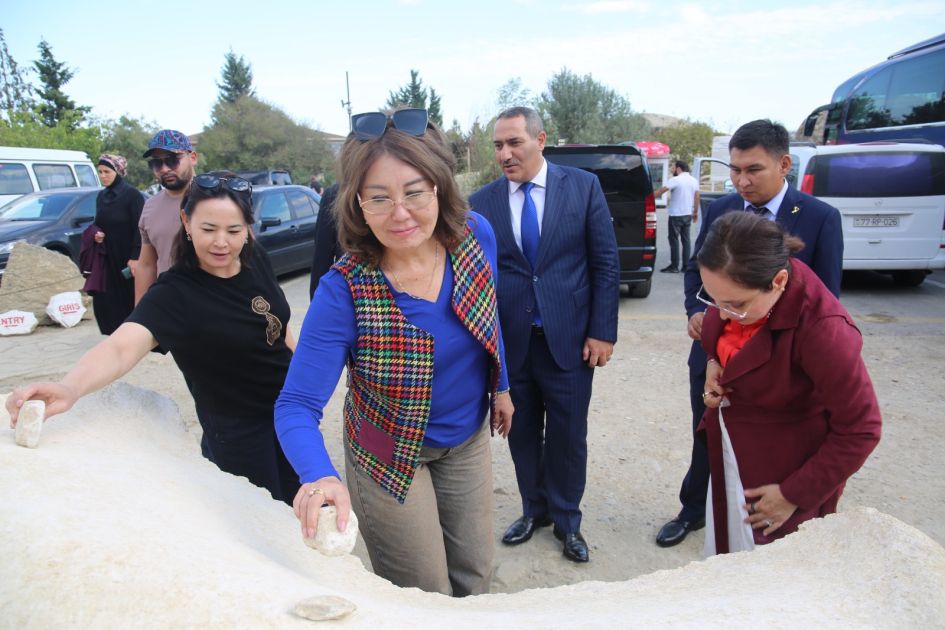Gobustan Reserve, Tanbaly Complex hold joint seminar [PHOTOS]
![Gobustan Reserve, Tanbaly Complex hold joint seminar [PHOTOS]](https://www.azernews.az/media/2024/10/10/ofkprefrfe3.jpg)
A scientific seminar titled "Rock Art as Universal Heritage Monuments" has been held at Gobustan State Historical and Cultural Reserve, Azernews reports.
The event was organized within Memorandum of Mutual Cooperation signed between Azerbaijan's Gobustan State Historical and Cultural Reserve and Artistic Reserve and Kazakhstan's Tanbaly State Historical-Cultural and Natural Reserve.
The seminar featured lectures on the condition, protection, restoration, and conservation of the monuments located within the territories of both reserves. Participants discussed the results of scientific research, strategies for organizing the preservation of cultural heritage examples, and future prospects for collaboration between the two reserves.
Consultations were held regarding the possibility of conducting joint conferences, seminars, and training sessions focused on the protection, conservation, and rehabilitation of immovable historical and cultural monuments.
The event was attended by representatives from the State Service for the Protection, Development, and Restoration of Cultural Heritage under the Culture Ministry, specialists from the Azerbaijan National Academy of Sciences, and employees from various other reserves and museums.

Opening the event with a welcoming speech, director of the Gobustan State Historical and Cultural Reserve Vugar Isayev, discussed the cultural relations between the two countries, emphasizing that such initiatives significantly contribute to strengthening the friendship and cooperation among peoples and nations.
Director of the Tanbaly State Historical-Cultural and Natural Reserve Bibigul Dandykaeva spoke about Tanbaly monuments and the activities of the museum-reserve.
She stressed the importance of joint scientific research endeavors, the exchange of extensive experiences, and the implementation of cultural and educational projects, while also underscoring the necessity of further expanding collaborations as outlined in the memorandum.
A researcher of Gobustan's monuments and a Doctoral Candidate in History Idris Aliyev, provided valuable information about the excavations conducted in the area, as well as the material culture artifacts obtained from these sites. His insights into the historical significance of these discoveries were particularly illuminating for the audience.
As part of the seminar, attendees were given the opportunity to view a photo exhibition showcasing the Tanbaly monuments, which served as a visual representation of the rich cultural heritage shared between the two regions.
Concluding the seminar, participants were taken on a guided tour of the Gobustan Reserve, allowing them to explore the monumental rock carvings and archaeological sites that are characteristic of the region.

Gobustan State Historical and Cultural Reserve
Gobustan State Historical-Artistic Reserve is a destination that should be at the top of any history buff's list.
The area has been inhabited for thousands of years and boasts over 600,000 distinct paintings, ranging from 20,000 years old to as recent as 5,000 years ago. In 2007, Gobustan was declared a UNESCO World Cultural Heritage Site.
Among the 6,000 drawings found in Gobustan are petroglyphs - stone and iron-age figures depicting hunting scenes, ceremonies, and rituals.
The famous explorer Thor Heyerdahl investigated the Gobustan petroglyphs and concluded that the oldest known images of a pirogue boat are found there.
He also made a sensational hypothesis about a connection between Norwegians and Azerbaijanis, suggesting that the ancestors of Scandinavians migrated from Azerbaijan.
Most of the rock engravings in Gobustan depict primitive men, animals, battle scenes, and other cultural practices.
In addition to the petroglyphs, visitors can see the musical gemstone known as Gaval Dash, which produces a tambourine-like sound when struck in various places.
Many Azerbaijani musicians have used Gaval Dash to create wonderful music pieces.
The musical stone and the Yallı chain dance were also featured in the interval act of the semi-final of the Eurovision Song Contest 2012 held in Baku.
There is also a stone slab with a Latin inscription from the first century, left behind by the 12th Roman legion of Emperor Domitian, indicating their stay in the area.
Gobustan has been granted national status since 2006. The reserve's main goal is to safeguard the ancient rock carvings and burial mounds found in the area.
Every year, this awe-inspiring open-air museum attracts thousands of visitors from all over the world.
Tanbaly State Historical-Cultural and Natural Reserve
The Tamgaly petroglyphs were discovered by an archaeological team led by A.G. Maksimova in 1957. Since the 1970s, A.N. Maryashev was engaged in the study of petroglyphs, later an expedition led by him, as well as A.G. Medoev, who made a significant contribution to the study of petroglyphs of Kazakhstan.
In 1999, the Tamgaly was included in the UNESCO Tentative List of World Heritage Sites.
In October 2001, by a special decree of the Government of the Republic of Kazakhstan, the monument was included in the State List of Historical and Cultural Monuments of Republican Significance under the name "Tamgaly Complex".
The Tamgaly archaeological site is made up of various cultural elements, including burial sites, altars, quarries, and rock carvings. These features are grouped around several ancient sanctuaries, showing a rich history that spans different time periods.
----
Laman Ismayilova is AzerNews’ staff journalist, follow her on Twitter: @lmntypewriterrr
Follow us on Twitter @AzerNewsAz
Here we are to serve you with news right now. It does not cost much, but worth your attention.
Choose to support open, independent, quality journalism and subscribe on a monthly basis.
By subscribing to our online newspaper, you can have full digital access to all news, analysis, and much more.
You can also follow AzerNEWS on Twitter @AzerNewsAz or Facebook @AzerNewsNewspaper
Thank you!





